What We’re Reading: April 27th
Review: Venus Flytrap: How an excitable, carnivorous plant works
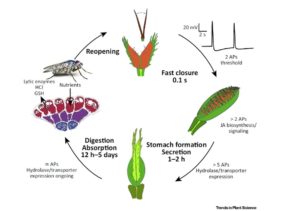 The one sure-fire way to get children excited about plants is to show them how a Venus flytrap works. But how does it work? We’ve all heard that the trap “counts” the number times it is triggered, and that it requires two or more touches in quick succession to close – but how does it count? Hedrich and Neher have compiled all the answers to questions curious youngsters might throw at you (and many that they probably wouldn’t) in this fine review, from how the Venus flytrap recognizes and digests its prey, to the evolutionary origins of carnivory in plants. It goes without saying that this would be a fun article to read with students. (Summary by Mary Williams) Trends Plant Sci. 10.1016/j.tplants.2017.12.004
The one sure-fire way to get children excited about plants is to show them how a Venus flytrap works. But how does it work? We’ve all heard that the trap “counts” the number times it is triggered, and that it requires two or more touches in quick succession to close – but how does it count? Hedrich and Neher have compiled all the answers to questions curious youngsters might throw at you (and many that they probably wouldn’t) in this fine review, from how the Venus flytrap recognizes and digests its prey, to the evolutionary origins of carnivory in plants. It goes without saying that this would be a fun article to read with students. (Summary by Mary Williams) Trends Plant Sci. 10.1016/j.tplants.2017.12.004
Insight: The impact of domestication and crop improvement on arbuscular mycorrhizal symbiosis in cereals: insights from genetics and genomics
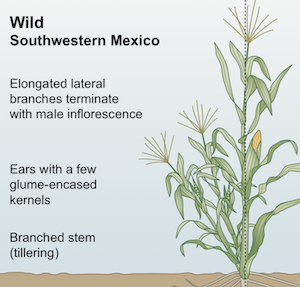 Cereals, such as rice, maize, wheat and sorghum are the nutritional base for many human societies, accounting for over 50% of the global caloric intake. Therefore, sustainability of (cereal) agriculture and quality of the cereals consumed is a great concern. This has led to an increasing interest into the potential benefit of arbuscular mycorrhizal (AM) symbiosis in cereals where “it has been hypothesized that the shift from the wild to cultivation, and … intensive breeding for high-input farming systems, has reduced the capacity of the major cereal crops to gain full benefit from AM interactions”. This recent review by Sawers et al. compiles information on how recruitment of plant metabolites and hormones act as signals and regulators in AM symbiosis and may be therefore regarded as targets of plant breeding, also focusing on the variations in host response to AM symbiosis. (Summary by Isabel Mendoza) New Phytol. 10.1111/nph.15152
Cereals, such as rice, maize, wheat and sorghum are the nutritional base for many human societies, accounting for over 50% of the global caloric intake. Therefore, sustainability of (cereal) agriculture and quality of the cereals consumed is a great concern. This has led to an increasing interest into the potential benefit of arbuscular mycorrhizal (AM) symbiosis in cereals where “it has been hypothesized that the shift from the wild to cultivation, and … intensive breeding for high-input farming systems, has reduced the capacity of the major cereal crops to gain full benefit from AM interactions”. This recent review by Sawers et al. compiles information on how recruitment of plant metabolites and hormones act as signals and regulators in AM symbiosis and may be therefore regarded as targets of plant breeding, also focusing on the variations in host response to AM symbiosis. (Summary by Isabel Mendoza) New Phytol. 10.1111/nph.15152
Insight: Phyllosphere microbiology: at the interface between microbial individuals and the plant host
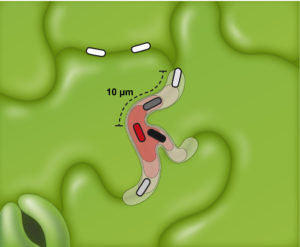 A bean leaf might not look big to us, but to a bacterium it is huge: authors Remus-Emsermann and Schlechter point out that in terms of scale, a microbe is to a leaf as a human is to the island of Trinidad. Like an island, a leaf has diverse inhabitants and provides diverse microhabitats. Much of what we know about phyllosphere microbiology comes from population-wide studies, which the authors argue need to be complemented by single-cell studies. They then describe some of the methods (and their limitations) for single-cell resolution studies of bacteria on leaves, and call for a greater focus on bacterial individuality. (Summary by Mary Williams). New Phytol. 10.1111/nph.15054
A bean leaf might not look big to us, but to a bacterium it is huge: authors Remus-Emsermann and Schlechter point out that in terms of scale, a microbe is to a leaf as a human is to the island of Trinidad. Like an island, a leaf has diverse inhabitants and provides diverse microhabitats. Much of what we know about phyllosphere microbiology comes from population-wide studies, which the authors argue need to be complemented by single-cell studies. They then describe some of the methods (and their limitations) for single-cell resolution studies of bacteria on leaves, and call for a greater focus on bacterial individuality. (Summary by Mary Williams). New Phytol. 10.1111/nph.15054
Identification and characterization of compounds that affect stomatal movements ($)
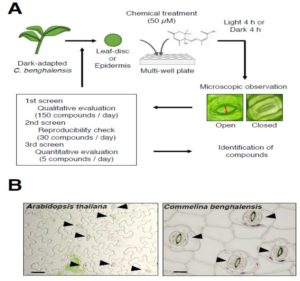 Toh et al. screened more than 20,000 chemicals from chemical libraries for compounds that regulate stomatal movement. They used Commelina benghalensis for their screen, as its stomata are about twice as large as those in Arabidopsis thaliana. They identified nine compounds that inhibited stomatal opening in the light, which they called SCL1 – 9, one of which, SCL1 (tert-butylhydroquinone), also strongly inhibits fusicoccin-induced opening. SCL1 interferes with blue-light induced phosphorylation of the plasma-membrane proton ATPase, and appears to act independently of ABA. When sprayed onto leaves, SCL1 conferred drought tolerance to both monocots and dicots. (Summary by Mary Williams) Plant Cell Physiol. 10.1093/pcp/pcy061
Toh et al. screened more than 20,000 chemicals from chemical libraries for compounds that regulate stomatal movement. They used Commelina benghalensis for their screen, as its stomata are about twice as large as those in Arabidopsis thaliana. They identified nine compounds that inhibited stomatal opening in the light, which they called SCL1 – 9, one of which, SCL1 (tert-butylhydroquinone), also strongly inhibits fusicoccin-induced opening. SCL1 interferes with blue-light induced phosphorylation of the plasma-membrane proton ATPase, and appears to act independently of ABA. When sprayed onto leaves, SCL1 conferred drought tolerance to both monocots and dicots. (Summary by Mary Williams) Plant Cell Physiol. 10.1093/pcp/pcy061
Guard cells in fern stomata are connected by plasmodesmata, but control cytosolic Ca2+ levels autonomously
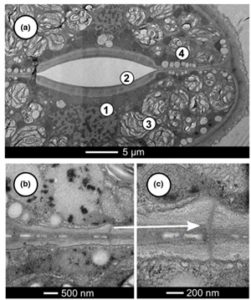 Potassium (K+) and calcium (Ca2+) ions are important for stomatal function in seed plants, however little is known about the contributions of these ions in the stomata of bryophytes and early-branching vascular plants. Voss et al. focus on how fern stomata regulate ion transport. Injection of K+ into guard cells (GC) activated outward ion channels, similar to what is seen in Arabidopsis. Voltage pulses preferentially activated Ca2+ release from sources closest to the microelectrode, triggering a rise in cytosolic Ca2+ levels. Interestingly, a fluorescent Ca2+ reporter was seen to move from one impaled GC into the adjacent GC, thus identifying interconnectedness of the cytosol of the GCs. This diffusion was slow and limited, suggestive of plasmodesmata, whose presence were confirmed by electron microscopy. These plasmodesmata act differently than the cell wall gap connecting GC in grasses, which does allow for rapid exchange of fluorescent dyes. On the other hand, voltage-dependent ion channels appear similar amongst varying species (Summary by Alecia Biel) New Phytol. 10.1111/nph.15153.
Potassium (K+) and calcium (Ca2+) ions are important for stomatal function in seed plants, however little is known about the contributions of these ions in the stomata of bryophytes and early-branching vascular plants. Voss et al. focus on how fern stomata regulate ion transport. Injection of K+ into guard cells (GC) activated outward ion channels, similar to what is seen in Arabidopsis. Voltage pulses preferentially activated Ca2+ release from sources closest to the microelectrode, triggering a rise in cytosolic Ca2+ levels. Interestingly, a fluorescent Ca2+ reporter was seen to move from one impaled GC into the adjacent GC, thus identifying interconnectedness of the cytosol of the GCs. This diffusion was slow and limited, suggestive of plasmodesmata, whose presence were confirmed by electron microscopy. These plasmodesmata act differently than the cell wall gap connecting GC in grasses, which does allow for rapid exchange of fluorescent dyes. On the other hand, voltage-dependent ion channels appear similar amongst varying species (Summary by Alecia Biel) New Phytol. 10.1111/nph.15153.
A moss glycosyltransferase produces a novel cell wall arabinoglucan
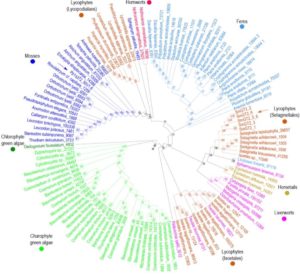 Plants produce a wide range of polysaccharides in their cell walls, some of which are restricted to certain species. Roberts et al. investigated a moss gene encoding an enzyme that resembles a mixed-linkage (1,3;1,4)-β-glucan (MLG) synthase. When expressed in tobacco, this enzyme produces a novel unbranched, unsubstituted arabinoglucan (AGlc) polysaccharide that consists of both glucose (Glcp) and arabinose (Araf) residues. The similarity between this novel arabinoglucan synthase and MLG synthases, as well as phylogenetic analysis of related genes, suggests that “the capacities to synthesize AGlc and MLG have a common evolutionary history” that was lost in the angiosperm lineage, followed by a later, independent origin for MLG synthases in monocots. (Summary by Mary Williams) Plant Cell 10.1105/tpc.18.00082.
Plants produce a wide range of polysaccharides in their cell walls, some of which are restricted to certain species. Roberts et al. investigated a moss gene encoding an enzyme that resembles a mixed-linkage (1,3;1,4)-β-glucan (MLG) synthase. When expressed in tobacco, this enzyme produces a novel unbranched, unsubstituted arabinoglucan (AGlc) polysaccharide that consists of both glucose (Glcp) and arabinose (Araf) residues. The similarity between this novel arabinoglucan synthase and MLG synthases, as well as phylogenetic analysis of related genes, suggests that “the capacities to synthesize AGlc and MLG have a common evolutionary history” that was lost in the angiosperm lineage, followed by a later, independent origin for MLG synthases in monocots. (Summary by Mary Williams) Plant Cell 10.1105/tpc.18.00082.
BRI1 and BAK1 interact with G proteins and regulate sugar-responsive growth and development in Arabidopsis
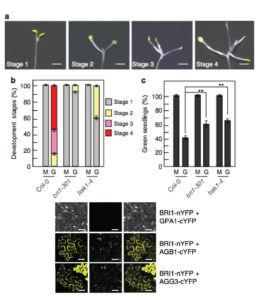 Sensing sugar is important, especially if you are a plant, as it helps you to decide whether to invest it in new tissues, or rather store it for later. Low levels of glucose promote seedling growth, while high concentrations repress the development. Peng et al. discovered that brassinosteroid signaling is playing a crucial role in sugar sensing. The interaction between a brassinosteroid receptor BRI1 and BAK1 increased at lower levels glucose. Interestingly, this led to an increased interaction between BRI1 and BAK1 with G-proteins, leading to G-protein activation through phosphorylation. The interaction between the studied proteins and activation of kinase activity was reduced at high glucose levels. As the studies were conducted in vitro, it seems that glucose molecules themselves are involved in the regulation of protein interaction and activation. The exact mechanism of glucose interaction with those proteins remains to be established. (Summary by Magdalena Julkowska) Naure Comms. 10.1038/s41467-018-03884-8
Sensing sugar is important, especially if you are a plant, as it helps you to decide whether to invest it in new tissues, or rather store it for later. Low levels of glucose promote seedling growth, while high concentrations repress the development. Peng et al. discovered that brassinosteroid signaling is playing a crucial role in sugar sensing. The interaction between a brassinosteroid receptor BRI1 and BAK1 increased at lower levels glucose. Interestingly, this led to an increased interaction between BRI1 and BAK1 with G-proteins, leading to G-protein activation through phosphorylation. The interaction between the studied proteins and activation of kinase activity was reduced at high glucose levels. As the studies were conducted in vitro, it seems that glucose molecules themselves are involved in the regulation of protein interaction and activation. The exact mechanism of glucose interaction with those proteins remains to be established. (Summary by Magdalena Julkowska) Naure Comms. 10.1038/s41467-018-03884-8
Comparative analysis of Arabidopsis ecotypes reveals a role for brassinosteroids in root hydrotropism
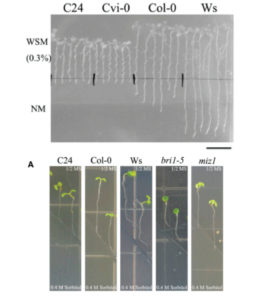 Plastic plant growth serves them well, as it ensures efficient exploration of the environment. A plant can direct the growth of its roots towards the water, but the mechanisms behind hydrotropism are still to be fully understood. Miao et al. performed a screen of 30 Arabidopsis accessions for altered root hydrotropic responses. The accessions were screened on agar plates where a low moisture gradient was simulated by adding glycerol and alginate. The transcriptional differences between accessions differing in hydrotropic growth highlighted the importance of proton efflux, calcium influx and hormone signaling. The authors discovered that brassinosteroid signaling is involved in modulating the hydrotropic response, as the bri1 mutants showed hypersensitive hydrotropism response. (Summary by Magdalena Julkowska) Plant Physiol. 10.1104/pp.17.01563
Plastic plant growth serves them well, as it ensures efficient exploration of the environment. A plant can direct the growth of its roots towards the water, but the mechanisms behind hydrotropism are still to be fully understood. Miao et al. performed a screen of 30 Arabidopsis accessions for altered root hydrotropic responses. The accessions were screened on agar plates where a low moisture gradient was simulated by adding glycerol and alginate. The transcriptional differences between accessions differing in hydrotropic growth highlighted the importance of proton efflux, calcium influx and hormone signaling. The authors discovered that brassinosteroid signaling is involved in modulating the hydrotropic response, as the bri1 mutants showed hypersensitive hydrotropism response. (Summary by Magdalena Julkowska) Plant Physiol. 10.1104/pp.17.01563
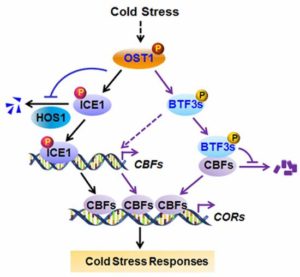 Ding et al. have just elucidated an important protein involved in the cold response of plants: BTF3L (basic transcription factor 3-like). The CBF/DREB (C-repeat binding factor/dehydration-responsive element protein) family of transcription factors are the main cold responsive pathway. The new article shows that BTF3L stabilizes CBF/DREB proteins. BTF3L is a beta subunit of the nascent polypeptide-associated complex which reversibly associates with ribosomes to stabilize generating peptides. Using a combination of in vitro and in vivo methods, the authors showed that OST1 (OPEN STOMATA 1, a kinase involved in activation of CBF/DREBs) interacts with and phosphorylates BTF3L during cold stress. This phosphorylation enhances, but is not required for, BTF3L binding and stabilization of CBF/DREB1 proteins. Until this point, most research on CBF/DREB transcription factors has taken place at the transcriptional level which makes identifying a post-translational stabilization of these proteins an important piece of the puzzle. This discovery continues to unravel cold regulation in plants and provides additional targets for investigations of non-model cold intolerant plant species. (Summary by Jennifer Robison) EMBO J. 10.15252/embj.201798228
Ding et al. have just elucidated an important protein involved in the cold response of plants: BTF3L (basic transcription factor 3-like). The CBF/DREB (C-repeat binding factor/dehydration-responsive element protein) family of transcription factors are the main cold responsive pathway. The new article shows that BTF3L stabilizes CBF/DREB proteins. BTF3L is a beta subunit of the nascent polypeptide-associated complex which reversibly associates with ribosomes to stabilize generating peptides. Using a combination of in vitro and in vivo methods, the authors showed that OST1 (OPEN STOMATA 1, a kinase involved in activation of CBF/DREBs) interacts with and phosphorylates BTF3L during cold stress. This phosphorylation enhances, but is not required for, BTF3L binding and stabilization of CBF/DREB1 proteins. Until this point, most research on CBF/DREB transcription factors has taken place at the transcriptional level which makes identifying a post-translational stabilization of these proteins an important piece of the puzzle. This discovery continues to unravel cold regulation in plants and provides additional targets for investigations of non-model cold intolerant plant species. (Summary by Jennifer Robison) EMBO J. 10.15252/embj.201798228
Increase in monoderm bacteria in drought-delayed early sorghum root microbiomes
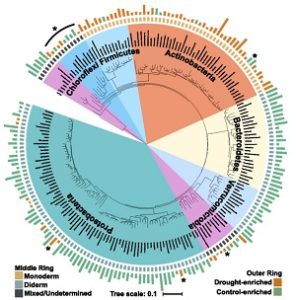 Drought stress drastically decreases crop productivity. Some root-associated bacteria have been shown to decrease the negative effects of drought stress on plants, but the role of drought in the development of the root microbiome has not been studied. Xu and colleagues use root metabolomics and 16S rRNA amplicon and metatranscriptome sequencing to elucidate the impact of drought on the development of the early sorghum root microbiome. Drought delays the development of the root microbiome and increases the abundance and activity of monoderm bacteria (bacteria without an outer cell membrane and with thick cell walls). The shift in community composition is correlated with altered plant metabolism and with the increased activity of bacterial ABC (ATP-binding cassette) transporter genes. Inoculating soil with monoderm isolates increases the colonization of sorghum roots during drought and positively impacts plant growth. These results describe the effects of drought on the root microbiome and indicate the importance of temporal sampling when studying microbiomes. (Summary by Julia Miller) Proc. Natl. Acad. Sci. USA 10.1073/pnas.1717308115
Drought stress drastically decreases crop productivity. Some root-associated bacteria have been shown to decrease the negative effects of drought stress on plants, but the role of drought in the development of the root microbiome has not been studied. Xu and colleagues use root metabolomics and 16S rRNA amplicon and metatranscriptome sequencing to elucidate the impact of drought on the development of the early sorghum root microbiome. Drought delays the development of the root microbiome and increases the abundance and activity of monoderm bacteria (bacteria without an outer cell membrane and with thick cell walls). The shift in community composition is correlated with altered plant metabolism and with the increased activity of bacterial ABC (ATP-binding cassette) transporter genes. Inoculating soil with monoderm isolates increases the colonization of sorghum roots during drought and positively impacts plant growth. These results describe the effects of drought on the root microbiome and indicate the importance of temporal sampling when studying microbiomes. (Summary by Julia Miller) Proc. Natl. Acad. Sci. USA 10.1073/pnas.1717308115
Emergence of N-hydroxy-pipecolic acid as a key long-distance immunity signal in Arabidopsis
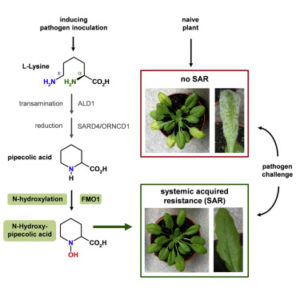 Systemic acquired resistance is a form of long-distance immunity employed by plants to protect distal uninfected tissues upon localized pathogen attack. Over the past two decades, a number of putative long-distance signals have been described as regulators of systemic immunity including the lysine catabolite pipecolic acid (Pip). Two recent studies expand on this knowledge (Chen et al. bioRxiv; Hartmann et al. Cell) by identifying Pip-derived N-hydroxy-pipecolic acid (NHP) as a specialized SAR metabolite that accumulates in distal tissues and primes plants for enhanced disease resistance. Importantly, both studies independently confirmed that the SAR regulator FMO1 (FLAVIN-DEPENDENT-MONOXYGENASE1) acts as a pipecolate N-hydroxylase that is essential for the production of NHP in planta during SAR. Together, these studies support the role of NHP as a key mobile immune regulator that is critical for the establishment of systemic disease resistance in plants. (Summary by Phil Carella) (Chen et al. bioRxiv ; Hartmann et al. Cell 10.1016/j.cell.2018.02.049).
Systemic acquired resistance is a form of long-distance immunity employed by plants to protect distal uninfected tissues upon localized pathogen attack. Over the past two decades, a number of putative long-distance signals have been described as regulators of systemic immunity including the lysine catabolite pipecolic acid (Pip). Two recent studies expand on this knowledge (Chen et al. bioRxiv; Hartmann et al. Cell) by identifying Pip-derived N-hydroxy-pipecolic acid (NHP) as a specialized SAR metabolite that accumulates in distal tissues and primes plants for enhanced disease resistance. Importantly, both studies independently confirmed that the SAR regulator FMO1 (FLAVIN-DEPENDENT-MONOXYGENASE1) acts as a pipecolate N-hydroxylase that is essential for the production of NHP in planta during SAR. Together, these studies support the role of NHP as a key mobile immune regulator that is critical for the establishment of systemic disease resistance in plants. (Summary by Phil Carella) (Chen et al. bioRxiv ; Hartmann et al. Cell 10.1016/j.cell.2018.02.049).
Women in STEMM: Will the gender gap close in your lifetime?
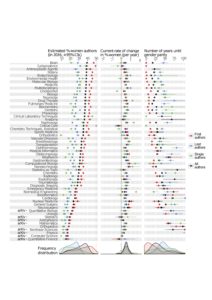 Gender inequality has been a much-discussed topic in recent years, and many studies on gender inequality relating to employment, business success, and opportunities for education have recently been published. Academia is no different, and gender inequality is still a major concern in the Science, Technology, Engineering, Mathematics and Medicine (STEMM) fields. Although many agree that the gender gap is smaller today than in the past, quantifying the gap and calculating the rate of change across disciplines have not been done, until a recent study by Holman et al. The study investigated the number of men and women authors of more than 10 million academic publications, their positions (first, middle, last or single author) and predicted how long, if ever, it will take to reach gender parity. Some of their results were concerning; many major research-producing, wealthy countries, such as Japan, Germany and Switzerland, displayed pronounced STEMM gender inequality; certain male-biased disciplines, such as physics, surgery, computer science and mathematics, displayed a persistent gender gap that will not reach parity in the next 100 years, if at all; and women are far less likely to be commissioned to write papers, submit to and publish in high-impact journals, or be invited keynote speakers at conferences. Although the study did highlight some positives (more gender equality across Europe, South America and Africa, and a general trend towards gender parity across most disciplines) efforts must be focused on recruiting and retaining women researchers across disciplines, reforming the academic publishing and peer review system, and improving support for demands outside the workplace. These interventions may decrease the time to gender parity across STEMM fields. See https://lukeholman.github.io/genderGap/ for a web app allowing easy access to the data used in this study. (Summary by Danielle Roodt Prinsloo) PLOS Biol. 10.1371/journal.pbio.2004956
Gender inequality has been a much-discussed topic in recent years, and many studies on gender inequality relating to employment, business success, and opportunities for education have recently been published. Academia is no different, and gender inequality is still a major concern in the Science, Technology, Engineering, Mathematics and Medicine (STEMM) fields. Although many agree that the gender gap is smaller today than in the past, quantifying the gap and calculating the rate of change across disciplines have not been done, until a recent study by Holman et al. The study investigated the number of men and women authors of more than 10 million academic publications, their positions (first, middle, last or single author) and predicted how long, if ever, it will take to reach gender parity. Some of their results were concerning; many major research-producing, wealthy countries, such as Japan, Germany and Switzerland, displayed pronounced STEMM gender inequality; certain male-biased disciplines, such as physics, surgery, computer science and mathematics, displayed a persistent gender gap that will not reach parity in the next 100 years, if at all; and women are far less likely to be commissioned to write papers, submit to and publish in high-impact journals, or be invited keynote speakers at conferences. Although the study did highlight some positives (more gender equality across Europe, South America and Africa, and a general trend towards gender parity across most disciplines) efforts must be focused on recruiting and retaining women researchers across disciplines, reforming the academic publishing and peer review system, and improving support for demands outside the workplace. These interventions may decrease the time to gender parity across STEMM fields. See https://lukeholman.github.io/genderGap/ for a web app allowing easy access to the data used in this study. (Summary by Danielle Roodt Prinsloo) PLOS Biol. 10.1371/journal.pbio.2004956



